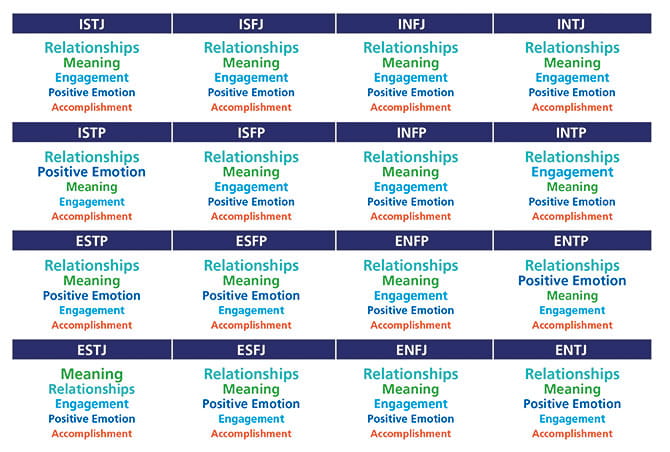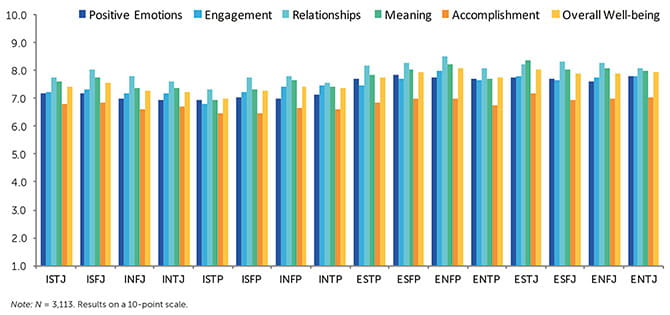Well-being and type: what’s the connection?
Dr. Martin Boult Senior Director, Professional Services and International Training, and Psychologist, CPP
In my previous blog, I shared some high-level tips for improving employee well-being based on a research project by CPP, Inc. Due to its global reach, the research looks at workplace well-being across 87 countries, and how it varies according to MBTI personality types. We have compiled the detailed results from the research in the Well-being and MBTI® Personality Type in the Workplace white paper. However, this week, we’ll focus on the individual – the influence of your MBTI personality type on well-being.
Well-being PERMA recap
I’ll refer to the PERMA model during this blog, so here’s a short reminder of what it is. Developed by Martin Seligman1, the PERMA model proposes that positive well-being, or ‘flourishing’, is more than just happiness. It comprises the following factors:
- Positive Emotions – feelings of happiness, contentment, pleasure
- Engagement – deep psychological connection and absorption in an activity or cause
- Relationships – mutual feelings of caring, support, satisfaction
- Meaning – having a sense of purpose and direction
- Accomplishment – pursuing success or mastery for its own sake
Which type reports the highest workplace well-being?
In our study, of more than 3000 people, all MBTI personality types reported generally positive levels of workplace well-being (average score of 7.62 out of 10 for the whole sample of respondents), but there were differences. The MBTI type reporting the highest overall well-being was ENFP (average score of 8.08 out of 10), while the type reporting the lowest well-being was ISTP (average score of 7.00 out of 10). Although the difference in overall well-being found between these two MBTI types was statistically significant, the size of the difference was relatively small. We also found that people with a preference for Extraversion (E) tended to report higher well-being than those who prefer Introversion (I).
Overall workplace well-being for each MBTI® personality type (maximum score = 10, minimum score = 0). N=3113
This finding is consistent with previous research and may be the result of the different kind of activities E and I types use to support their workplace well-being. As our research focused on people’s well-being in the workplace rather than outside of work, there may be elements of the workplace that impact the well-being of I types. Although this finding requires more investigation, it is possible that I types may rate their well-being differently outside of work, particularly if the typical work environment is more conducive to supporting the well-being of E types. Also worth noting was that people with a preference for Feeling (F) were more likely to have higher levels of well-being than those preferring Thinking (T). Previous research has found F types report greater comfort, enjoyment and perceived value of using strategies to improve their happiness than T types2. This suggests that T types may not focus on their well-being to the same extent as F types. Such a suggestion presents an opportunity for T types to address this point.
Ranking the five PERMA factors
The research also asked people to score their personal experience of the five elements of the PERMA well-being model at work. The factor which scored the highest for 15 of the 16 MBTI personality types was Relationships (ESTJ types were the only type to rate Meaning as their highest factor). This is consistent with previous research3, which demonstrates that positive relationships not only provide support but also enhance people’s well-being at work.
Rank order of highest to lowest rated PERMA factors for each MBTI® Type
 click to enlarge
click to enlarge
The PERMA factor that scored the lowest for every personality type was Accomplishment. This suggests that strategies and actions to increase people’s sense of accomplishment – ‘the pursuit of success or mastery for its own sake’ – may do the most to improve well-being across the board. The question is, what constitutes success or mastery for different types? Accomplishment is experienced when people are using their talents to achieve meaningful outcomes. Making a concerted effort to help people to do this in their work can be the lever to improve this aspect of well-being.
What do different MBTI types do to improve their well-being?
We asked people which activities they did to support their well-being. The research showed that Extraverted types favour interpersonally-oriented activities (eg spending time with family/friends, going to parties), while Introverted types endorse intrapersonally-oriented activities (eg reading, playing video games, meditation) to support their well-being. ISTP types were among those types reporting the lowest effectiveness scores for 14 of the 25 activities surveyed. The activity ISTP types rated as the most effective was ‘playing video games’, which may relate to motivational aspects of their type (goal oriented, introverted environment). ENFP types, on the other hand, rated most activities as ‘high’ in their effectiveness for improving well-being. This fits with our experience of ENFP types frequently reporting they are motivated by opportunities to try and experience a variety of activities in life. A summary of what each personality type group found effective or less effective is presented in the following table.
Effectiveness of well-being activities by MBTI® Type
Summary
Our research shows that having positive and supportive relationships at work is important for people’s well-being, irrespective of their personality type or geographic region. Accomplishment, as defined in the PERMA model, is an area offering the greatest potential improvement for workplace well-being. Organisations and employers should consider this as an area to improve if they want to realise the benefits of higher levels of employee well-being.
When it comes to activities that support well-being, organisations need to consider a range of strategies. Activities that relate to aspects of personality type can be the most successful way to support and enhance people’s well-being at work. Awareness of type is a crucial starting point for raising levels of well-being in the workplace.
More findings – including the links between well-being, personality type, geographical location and the most frequent and effective methods for supporting workplace well-being – will be made available from this research.
1 Seligman, M. (2011). Flourish: A visionary new understanding of happiness and well-being. New York: Free Press.
2 Huszczo, G & Endres, M. (2013) Joint Effects of Gender and Personality on Choice of Happiness Strategies. Europe's Journal of Psychology, Vol. 9(1), 136–149. doi:10.5964/ejop.v9i1.536
3 Steffens, N. K., Haslam, A. S., Schuh, S. C, Jetten, J., & van Dick, R. (2016, July). A meta-analytic review of social identification and health in organizational contexts. Personality and Social Psychology Review, 1-33

